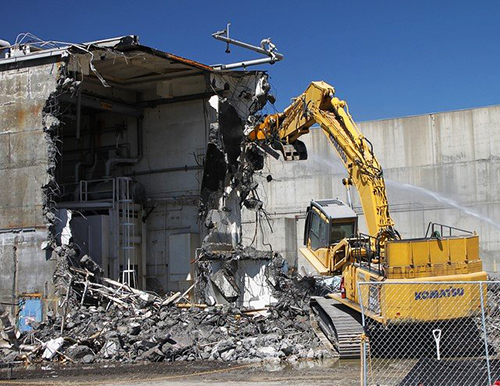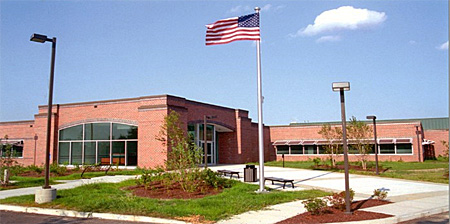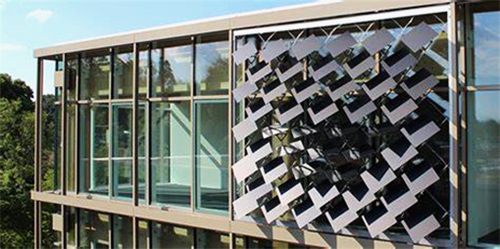Overview
Within This Page
Building construction and operations can have extensive direct and indirect impacts on the environment, on society, and the economy, which are commonly referred to as the 3 P's ('People', 'Planet', 'Pocketbook'). The field of sustainable design seeks to balance the needs of these areas by using an integrated approach to create "win-win-win" design solutions.
The main objectives of sustainable design are to reduce, or completely avoid, depletion of critical resources like energy, water, land, and raw materials; prevent environmental degradation caused by facilities and infrastructure throughout their life cycle; and create built environments that are livable, comfortable, safe, and productive.
Buildings use resources (energy, water, raw materials, etc.), generate waste (construction, occupancy, and demolition), emit potentially harmful atmospheric emissions, and fundamentally change the function of land, and the ability of that land to absorb and capture water into the ground. Building owners, designers, and builders each face unique challenges to meet demands for new and renovated facilities that are accessible, secure, healthy and productive, while minimizing any negative impacts upon society, the environment, and the economy.

Millions of tons of waste are generated during the construction process, making it essential to incorporate more sustainable design and construction practices into a project.
Photo Credit: EPA
In addition to including sustainable design concepts in new construction, sustainable design advocates encourage retrofitting existing buildings rather than building anew. Retrofitting an existing building can often be more cost-effective than building a new facility. Designing major renovations and retrofits for existing buildings to include sustainable design attributes reduces operation costs and environmental impacts, and can increase building resiliency. The "embodied energy" of the existing building (a term expressing the cost of resources in both human labor and materials consumed during the building's construction and use) is squandered when the building is allowed to decay or to be demolished.
Source: EPA, USGBC
While the definition of sustainable building design evolves over time, six fundamental principles persist:
-
Optimize Site Potential
Creating sustainable buildings starts with proper site selection, including consideration of the reuse or rehabilitation of existing buildings or the use of a brownfield, greyfield, or previously developed site. The location, orientation, and landscaping of buildings affect local ecosystems, transportation methods, and energy use. Incorporating smart growth principles into the project development process is important whether a project is a single building, a campus, or a large complex such as a military base. Siting for physical security is a critical issue in optimizing site design, including locations of access roads, parking, vehicle barriers, and perimeter lighting. Whether designing a new building or retrofitting an existing building, site design must integrate with sustainable design to achieve a successful project. The site of a sustainable building should reduce, control, and/or treat storm-water runoff. Strive to support native flora and fauna of the region in the landscape design. -
Optimize Energy Use
With ever-increasing demand on fossil fuel resources and growing concerns about energy independence and security, and impacts of global climate change becoming more evident, it is essential to find ways to reduce energy loads, increase efficiency, and maximize the use of renewable energy sources in federal facilities. Improving the energy performance of existing buildings is important to increasing our energy independence. Government and private sector organizations are increasingly committing to building and operating net zero energy buildings to significantly reduce dependence on fossil fuels. -
Protect and Conserve Water
In many parts of the United States, fresh water is an increasingly scarce resource. Since building fundamentally changes the ecological and hydrological function of non-built land, a sustainable building should seek to minimize the impervious cover created through practices that can reduce those impacts while using water efficiently, and reusing or recycling water for on-site use, when feasible. The effort to bring drinkable water to our household faucets consumes enormous energy resources in pumping, transport, and treatment. Often potentially toxic chemicals are used to make water potable. The environmental and financial costs of sewage treatment are significant. -
Optimize Building Space and Material Use
While the world population continues to grow (to more than 9 billion by 2050), consumption of natural resources will continue to increase and the demand for additional goods and services will continue to stress available resources. It is critical to achieve an integrated and intelligent use of materials that maximizes their value, prevents 'upstream' pollution, and conserves resources. A sustainable building is designed and operated to use and reuse materials in the most productive and sustainable way across its entire life cycle, and is adaptable for reuse during its life cycle. The materials used in a sustainable building minimize life-cycle environmental impacts such as global warming, resource depletion, and toxicity. Environmentally preferable materials reduce impacts on human health and the environment, and contribute to improved worker safety and health, reduced liabilities, and reduced disposal costs.

EPA's New England Regional Laboratory (NERL) achieved a LEED Gold rating. From conception the project was charged to "make use of the best commercially-available materials and technologies to minimize consumption of energy and resources and maximize use of natural, recycled and non-toxic materials." Chelmsford, MA
-
Enhance Indoor Environmental Quality (IEQ)
The indoor environmental quality (IEQ) of a building has a significant impact on occupant health, comfort, and productivity. Among other attributes, a sustainable building maximizes daylighting, has appropriate ventilation and moisture control, optimizes acoustic performance, and avoids the use of materials with high-Volatile Organic Compounds (VOC) emissions. Principles of IEQ also emphasize occupant control over systems such as lighting and temperature. -
Optimize Operational and Maintenance Practices
Consideration of a building's operating and maintenance issues during the preliminary design phase of a facility will contribute to improved working environments, higher productivity, reduced energy and resource costs, and prevention of system failures. Encourage building operators and maintenance personnel to participate in the design and development phases, to ensure optimal operations and maintenance of the building and the features such as storm water facilities designed to reduce the impact of the building on the land. Recruit, develop, and train highly skilled maintenance personnel to operate increasingly sophisticated high-performance buildings. Designers can specify materials and systems that simplify and reduce maintenance requirements; require less water, energy, and toxic chemicals / cleaners to maintain; and are cost-effective and reduce life-cycle costs. Also, design facilities to include metering, to track the progress of sustainability initiatives, including reductions in energy and water use and waste generation, in the facility and on-site.
Related Issues
Building resiliency is the capacity of a building to continue to function and operate under extreme conditions, such as (but not limited to) extreme temperatures, sea level rise, natural disasters, and man-made hazards including terrorism, etc. As the built environment faces the impending effects of global climate change, building owners, designers, and builders must design facilities to optimize building resiliency.
Building adaptability is the capacity of a building to be used for multiple uses and in multiple ways over the life of the building. For example, designing a building with a modular and integrated approach to infrastructure delivery and interior systems (furniture, ceiling systems, demountable partitions and access floors) allows the building to support multiple uses and multiple futures. Additionally, using sustainable design strategies and technologies allows for a building to adapt to different environments and conditions.

Adaptive façades are able to adapt to changing conditions including short-term weather fluctuations, diurnal cycles, or seasonal patterns, contributing to the reduction in heat gain and energy loads.
Photo Credit: ETH Zurich
Relevant Codes, Laws, and Standards
Codes and Laws
- Energy Independence and Security Act of 2007
- Energy Policy Act of 2005 (EPACT)
- Executive Order 13834, "Efficient Federal Operations"
- International Green Construction Code (ICC IgCC), International Code Council
Standards
Additional Resources
Federal Agencies
- Department of Defense
- Department of Energy
- Building Technologies Program, Office of Energy Efficiency and Renewable Energy (EERE)
- Building Performance Database, Office of Energy Efficiency and Renewable Energy (EERE)
- Commercial Buildings Integration, Office of Energy Efficiency and Renewable Energy (EERE)
- Federal Energy Management Program (FEMP), Office of Energy Efficiency and Renewable Energy (EERE)
- FEMP Interagency Sustainability Working Group
- Department of Health and Human Services
- Health in Buildings Roundtable, National Institutes of Health
- Department of State
- Department of Veterans Affairs
- Sustainable Design Manual, Office of Construction and Facilities Management (CFM)
- Sustainable Design Standards
- Environmental Protection Agency
- Greening EPA
- Green Building Archived web pages
- General Services Administration
- NASA
Publications
- Federal
- Achieving High-Performance Federal Facilities: Strategies and Approaches for Transformational Change by the National Academies Press. 2011.
- Building Catalog: Case Studies of High Performance Buildings, DOE Office of Energy Efficiency and Renewable Energy (EERE)
- FEMA P-798 Natural Hazards and Sustainability for Residential Buildings, Federal Emergency Management Agency. 2010.
- Field Guide for Sustainable Construction by the Pentagon Renovation and Construction Program Office, Department of Defense. 2004.
- Green Building Certification System Review and Appendices by the U.S. General Services Administration. 2012.
- The Greenest Building: Quantifying the Environmental Value of Building Reuse , National Trust for Historic Preservation
- Greening Federal Facilities Guide by U.S. Department of Energy. 2001.
- Implementing Instructions—Sustainable Locations for Federal Facilities Council on Environmental Quality. 2011.
- Innovative Workplace Strategies by U.S. General Services Administration, Office of Governmentwide Policy, Office of Real Property. Dec 2003.
- Managing Your Environmental Responsibilities: A Planning Guide for Construction and Development by U.S. Environmental Protection Agency. 2005.
- NASA Agency Sustainable Policy Handbook for Facilities. 2010.
- The New Sustainable Frontier: Principles of Sustainable Development by U.S. General Services Administration. 2009.
- Office of the Federal Chief Sustainability Officer (CSO), Council on Environmental Quality
- Real Property Sustainable Development Guide by U.S. General Services Administration, Office of Governmentwide Policy, Office of Real Property. 2000.
- Sustainability Matters by U.S. General Services Administration. 2008.
- Sustainable Critical Infrastructure Systems: A Framework for Meeting 21st Century Imperatives by the National Academies Press. 2009.
- Sustainable Building Rating Systems Summary, U.S. General Services Administration. 2006.
- Sustainable Development and Society by U.S. General Services Administration, Office of Governmentwide Policy, Office of Real Property. 2004.
- Organizations, States, and Universities
- Bridging the Gap: Fire Safety and Green Buildings - A Fire and Safety Guide to Green Construction by the National Association of State Fire Marshalls. 2010.
- Harvard University Green Labs Program
- High Performance Building Guidelines by New York City Department of Design and Construction. April 1999.
- Minnesota Sustainable Building Guideline: Buildings, Benchmarks & Beyond (B3) by Regents of the University of Minnesota, Twin Cities Campus, College of Architecture and Landscape Architecture.
- Cost
- Green Building Costs and Financial Benefits by Gregory H. Kats. 2003.
- Sustainable Federal Facilities: A Guide to Integrating Value Engineering, Life-Cycle Costing, and Sustainable Development by Federal Facilities Council. Washington, DC: National Academy Press, 2001.
- Magazines and E-Newsletters
- BuildingGreen
- eco-structure Magazine—A bi-monthly magazine dedicated to improving the environmental performance of buildings and their surroundings. (2007–2013)
- SmartMarket Reports, McGraw-Hill Construction/Dodge Data & Analytics
- GreenBIM 2010.
Organizations
- The Green Building Initiative (GBI)
- Institute for Sustainable Infrastructure
- International Living Future Institute
- U.S. Green Building Council (USGBC)
Others
- ASTM International—A globally recognized leader in the development and delivery of international voluntary consensus standards. Today, some 12,000 ASTM standards are used around the world to improve product quality, enhance safety, facilitate market access and trade, and build consumer confidence.
- Austin Energy Green Building Program
- Building Research Information Knowledgebase (BRIK)—an interactive portal offering online access to peer-reviewed research projects and case studies in all facets of building, from predesign, design, and construction through occupancy and reuse.
- FedCenter.gov—FedCenter, the Federal Facilities Environmental Stewardship and Compliance Assistance Center, is a collaborative effort between the Office of the Federal Environmental Executive (OFEE), the U.S. Army Corps of Engineers Construction Engineering Research Laboratory, and the U.S. EPA Federal Facilities Enforcement Office, a one-stop source of environmental stewardship and compliance assistance information focused solely on the needs of federal government facilities.
- Green Building Advisor
Tools
- GSA Sustainable Facilities Tool (SFTool)—SFTool's immersive virtual environment addresses all your sustainability planning, designing and procurement needs.
- The Waste Reduction Model (WARM)—WARM calculates and totals life cycle GHG emissions avoided through alternative waste management practices (reduced, recycled, combusted, or composted) in comparison to a baseline scenario (landfilled) for various materials
- Building Life-Cycle Cost (BLCC)—BLCC conducts economic analyses by evaluating the relative cost effectiveness of alternative buildings and building-related systems or components.








